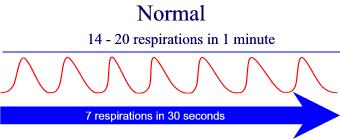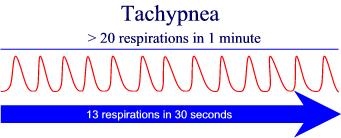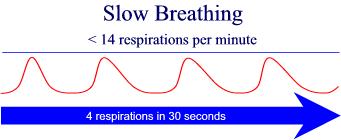
|
Lesson 4: Vital Signs
Respiration is the process that brings oxygen into the body and removes carbon dioxide waste. The exchange occurs in the lungs. Respiration occurs in two phases: internal and external.
a. Internal respiration is the process by which oxygen is taken from the bloodstream into the cell and carbon dioxide is removed from the cell to the bloodstream.
b. External respiration refers to delivery of oxygen to the lungs so that it can be taken into the bloodstream. External respiration (breathing) has two components: Inspiration, the process of taking air into the lungs; and expiration, expelling air from the lungs.
c. It is the rate of external respiration that is measured. The normal adult rate is 14 to 20 breaths per minute. Women have a more rapid rate than men. Newborns have a normal rate of about 40. Children have a normal rate of 25 to 30.
d. Respiration is controlled and regulated by the respiratory center in the brain and by the amount of carbon dioxide in the blood. Respiration is involuntary and automatic. You can control the action of your breathing to some extent, but only for a limited time. If automatic breathing does not occur, a breathing disorder exists.
a. Normal breathing is relaxed, effortless, and regular.
b. Rapid breathing is a rate above 20 breaths per minute, associated with increased activity or a disease process. The medical term is tachypnea.
c. Slow breathing is a rate below 14. It may also be described as shallow if the patient takes in and breathes out small amounts of air.
d. Difficult breathing describes when a person is making a definite effort to get more oxygen and get rid of carbon dioxide. Dyspnea is the term for difficult breathing. Dyspnea is also the term used for painful breathing, a subjective pattern, which must be stated by the patient. Dyspnea may be a temporary condition, such as when a runner gasps at the end of a race or when a person pants "to get his breathe" after climbing stairs. In some diseases, such as pneumonia, emphysema, or some types of heart conditions, breathing difficulty is more or less constant. Signs of breathing difficulties are: heaving of the chest and the abdomen, and cyanosis (a bluish tinge in the skin).
e. Orthopnea is the term used if the patient can breathe only when in an upright position.
f. Apnea is the absence of respirations.
g. Cheyne-Stokes is the term for cycles of breathing characterized by deep, rapid breaths for about 30 seconds, followed by absence of respirations for 10 to 30 seconds. Cheyne-Stokes respirations constitute a serious symptom and usually precedes death in cerebral hemorrhage, uremia, or heart disease.
|
The Brookside Associates Medical Education Division is dedicated to the development and dissemination of medical information that may be useful to medical professionals and those in training to become medical professionals. This website is privately-held and not connected to any governmental agency. The views expressed here are those of the authors, and unless otherwise noted, do not necessarily reflect the views of the Brookside Associates, Ltd., any governmental or private organizations. All writings, discussions, and publications on this website are unclassified.
© 2007 Medical Education Division, Brookside Associates, Ltd. All rights reserved



